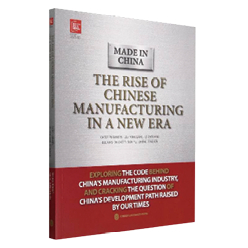
Made In China: The Rise of Chinese Manufacturing in a New Era
Editor-in-Chief: Sun Fu, Zheng Jingxin
Paperback, 183 pages
Published by Foreign Languages Press
Manufacturing is closely related to people’s daily life, laying a strong foundation for a large country and covering almost everything from embroidery needles to aircraft carriers. In the new era, China continues to maintain its status as the world’s largest manufacturing country, and is accelerating its progress towards “Created in China.”
Made In China: The Rise of Chinese Manufacturing in a New Era selects 10 typical cities: Shenzhen, Dongguan, Foshan, Wuhan, Hefei, Ningbo, Taizhou, Wuxi, Nantong, and Kunshan, and conducts in-depth research into these cities’ representative enterprises, exploring their evolution path and cracking the code of China’s manufacturing industry in the new era.
In the first chapter, the author tells the story of Shenzhen, an iconic city of China’s reform and opening-up drive. On August 26, 1980, the Shenzhen Special Economic Zone was officially established. Encouraged by the country’s preferential policies, Shenzhen leveraged funds and industrial transfers from neighboring Hong Kong, which gave rise to the development model of “front shop, back factory.” By adopting the “three-plus-one” trading mix, that is, custom manufacturing with materials, designs or samples supplied, and compensation trade, Shenzhen moved away from an agricultural economy to embrace industrialization and trade.
The city’s industrial structure is under constant transformation and upgrading. Intelligent manufacturing is now one of its priorities and the companies are accelerating their pace of digitalization. Shenzhen is now home to more than 400 national-level “little giant” enterprises, mostly concentrated in the manufacturing industry. It is also the city with the highest density of startups and the most vibrant small and medium-sized enterprises in China.
In the second chapter, the legend of “Made in Dongguan” unfolds. One of the “Four Tigers in Guangdong Province,” Dongguan leverages its advantageous geographical location, linked to Guangzhou in the north and Shenzhen in the south. The “world’s factory” started from scratch in manufacturing and became famous for its manufacturing industry, and in the process created countless economic miracles. It has moved away from labor-intensive industries to embrace digital and intelligent industries. Riding on the synergy of the Guangdong-Hong Kong-Macao Greater Bay Area, which has the largest semiconductor application market in China, Dongguan has developed an industrial layout with packaging testing and design as its core, and equipment, raw materials and application industries as its pillar.
In the third chapter, the author goes to Foshan, 20 kilometers from Guangzhou, whose manufacturing industry has reached a significant scale with highly flexible enterprises that produce components. Foshan has long been closely linked to the global supply chain, and its internal supply chain also boasts a complete ecosystem. This is very evident in the home appliances industry.
The fourth chapter takes us northward to the Yangtze River region where Wuhan, capital city of Hubei Province, is located by the Yangtze’s longest tributary, the Hanjiang River. In 1976, China’s first practical optical fiber was produced in the area southeast of Wuhan, which became the cradle of China’s optical communication industry. In 1991, the Wuhan Economic & Technological Development Zone came into being; then in 2001, the Donghu New Technology Development Zone, known as the “Optics Valley of China,” was designated a national industrial park of the opto-electronic industry. The Optics Valley brings together chip makers and fiber optic companies. Thus, a chip industry ecosystem, which includes actors in the fields of design, manufacturing, packaging, testing, and provision of raw materials, is taking shape, making Wuhan a hub of innovation.
The fifth chapter shares the experiences of Hefei, capital of Anhui Province, which has been one of the fastest-growing cities in China over the past 10 years. Hefei has abundant science education resources, including universities and research institutions, and the necessary conditions to transform its advantages in science education into economic advantage.
The sixth chapter unveils the secret of Ningbo’s success in becoming the “champion city of manufacturing” and the way it has secured the title. Ningbo, a harbor city in east China’s Zhejiang Province, boasts a well-developed private economy. “Made in Ningbo” has become a well-known label in many manufacturing industries. It is also home to a large number of rising startups. The city’s champion companies in different niche sectors continue to refine their technologies.
The seventh chapter explores the code behind Taizhou’s manufacturing industry, which is exemplary in the development of the local grassroots economy. Taizhou is also in Zhejiang Province. Since the introduction of the reform and opening-up policy in 1978, Jiangsu and Zhejiang have given birth to the widely-known south Jiangsu model and Wenzhou-Taizhou model of economic development. Over these years, Taizhou has become home to 73,000 manufacturing enterprises. Of them, 65 are publicly listed, 11 are state-level single-product champion enterprises, 32 state-level “little giant” companies, and two are state-level demonstration companies for technological innovation.
The story of Wuxi, a water city in east China’s Jiangsu Province, is told in the eighth chapter. It is one of the cradles of China’s national industry and commerce in modern history, and an important hub of the integrated circuit industry in China.
In the ninth chapter, Nantong, another city in Jiangsu, explains its development path from being the capital of light textiles to transforming into an advanced manufacturing base in the northern Yangtze River Delta.
The last chapter focuses on Kunshan, an outstanding county-level city in Jiangsu. Adjacent to Shanghai and Suzhou, its economic output is one of the highest among county-level cities across China. So far, it is the leading light among the top 100 counties of China.
The core of the manufacturing industry is constant innovation. Having been challenged by the reconstructed global industrial chain, Chinese manufacturing enterprises are striving to climb up to the high-end value chain, taking “Made in China” to a new stage of “Created in China.”